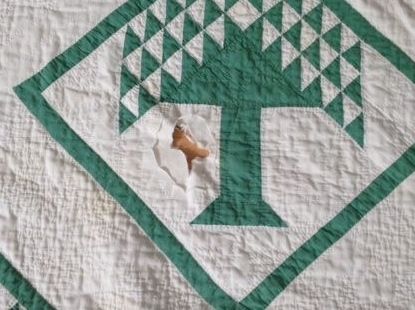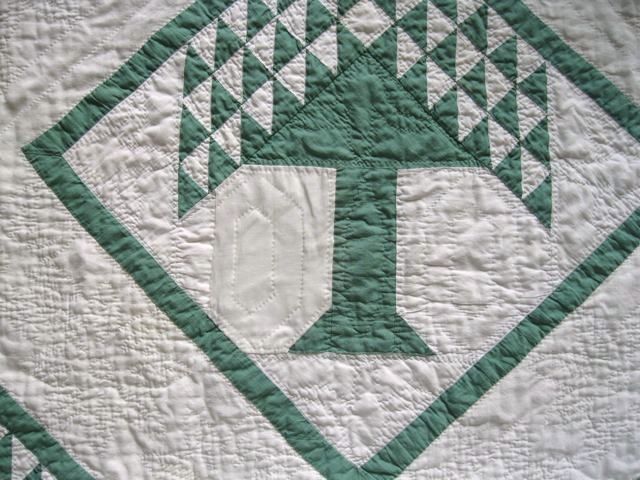Home Book Art Quilts About Quilt Repair Mending and Lessons Lectures and Workshops Quilt History Costumes Resumé Contact
Quilt Repair
Mending and Lessons
Learning to Repair How to Contact Me for Quilt Repair About Me Washing Antique Quilts
![]()
Learning to Repair
Workshop, Virtual - Description at Preserving Our Quilt Legacy


I offer an in-depth, 5 session workshop on quilt repair philosophy and techniques. You can attend the full workshop, or selected lectures on an alá carte basis. Registration for the full workshop includes lectures, how-to videos, supply samples, session recordings, group discussions, and more.
Questions about Your Quilt
I am always available for short questions via email. For a fuller assessment and/or instructions, you can sign up for one of the options below.
Repair Lessons, Virtual
I teach private lessons via Zoom, covering techniques, supplies, etc. These cost $75 for the first hour, and $50 per hour (or part of an hour, prorated) for additional time. You will need to send me a set of photos of the quilt and the damage prior to our lesson. How much time we'll spend depends on what your sewing skills are and what needs to be done.
(Photo instructions: one of the entire quilt, or as full as you can, front and back, and a few detail photos of the damage. Good, even lighting and focus is needed. I prefer larger rather than smaller photos. If you need to send them in more than one email, that is fine. Please only use email.) Register at AnnQuilts shop at Square.com.
Quilt Triage, Virtual
An assessment of age, condition, repair options, care options, etc. You will need to send me a set of photos of the quilt prior to our session.
Fee: $75. One hour.
(Photo instructions: one of the entire quilt, or as full as you can, front and back, and a few detail photos of the damage. Good, even lighting and focus is needed. I prefer larger rather than smaller photos. If you need to send them in more than one email, that is fine.)
(Note: This is not an appraisal and will not include a value estimation. For that you need to locate a certified appraiser, and I can give you some leads on that.) Register at my Square shop.
Repair Packet, Virtual
This choice gives you a more complete set of instructions than the single lessons. You'll send your quilt to me so I can assess it in detail. Then I will search in my stash for repair fabrics and send those to you when I return the quilt. (If there are things I don't have in my stash, you will go shopping for those.) I will prepare a demonstration and teaching video for you, and then we can have Q&A sessions via Zoom. You’d pay for my assessment and treatment plan, your personalized video, purchase of the repair fabrics from my stash, and instructional Zoom session(s). Email me to discuss this option. Minimum $250 plus round trip shipping of your quilt.
![]()
How to Contact Me for Quilt Repair
Partial retirement
I am, as of now, going into partial retirement. I have 40+ years of professional experience in quilt care and restoration. It’s been a great ride, and a difficult decision to slow down.
Occasional repair jobs
I will, however, be taking in occasional repairs on a case-by-case basis. If you would like for me to consider your quilt, please send a few photos.
Sending photos:
You can start by emailing me some photos.
Please send via email only - annquilts@comcast.net
• one of the entire front, or as full as you can
• one of the entire back, or a full as you can
• a few details of the damaged areas.
•I prefer higher resolution photos. Good, even lighting and focus is needed. If you need to send them in more than one email, that is fine, and the easiest way for me to view them.
• Also, please tell me the approximate size of the quilt, and answer as many questions as you can at the "Deciding How to Treat Your Quilt" section about how you value the quilt and your plans for future use.
If I say yes:
I can give you a general assessment and ballpark estimate via email, and will add your name to my waiting list if you want to proceed. Eventually, I will need to see the quilt and then I can give you a firm estimate. I will email you when your turn comes up. You would need to ship the quilt to me (Chicago area), which generally runs about $50-60 round trip.
If I say no:
This is not a comment on your quilt. I am greatly limiting my sewing time, and will work on only a small percentage of the quilts that I see.
Other people to contact:
Here are three people who have taken my workshop and worked with me for a while. I have been sending them jobs for over a year now. They are trustworthy and have great sewing skills. They all welcome quilts shipped from other locations. We continue to be in contact regularly to discuss quilts we are working on.
• Kristen Edens
Creatingquilts.com
creatingquilts4U@gmail.com
314-974-8463
I make and repair heirloom quilts, t-shirt quilts, and memory quilts.
My repairs focus on antique or vintage patchwork and appliqué quilts using techniques and fabrics from the original maker's era.
Please contact me through my website, text, or cell phone.
• Pamela Goffinet
Fair Hill, Maryland
pammap@zoominternet.net
www.pamelagoffinet.com
From vintage patchwork and embroidered crazy quilts (my favorite), to contemporary ones with pet damage, I enjoy the challenges of repairing quilts and preserving the family history that they represent. Examples of work can be seen on my website.
• Jennifer Borne
jennifer@cottageartsworkshop.com
As a quilter and quilt collector, I have a great appreciation for each stitch that goes into the creation of such treasured heirlooms. I also have many years experience in a variety of other needlework techniques, including crocheting, knitting, embroidery, cross stitch, needlepoint, hardanger, needle lace, rug hooking, garment sewing, and floor loom weaving. I have a great passion for the history of needlework and have extensive collections of antique needlework tools and books, sewing machines, irons, pincushions, and handcrafted needlework items from museum pieces to mundane household linens. I am passionate about keeping the art of needlework alive and am fortunate to have had the opportunity to recreate vintage needlework items from the past. And now I look forward to helping you preserve your cherished heirlooms for future generations to enjoy.
Switching my focus towards teaching:
I am switching my focus towards teaching quilt history lovers the philosophy and techniques that I have honed over 40+ years. This well be our next generation of quilt repair experts. Also, I love teaching quilt owners to mend and protect their own family heirlooms. Please use the following links to learn howto take my classes or to set up a lesson to learn how to do your repairs.
You can find information on my educational offerings here on my website:
About Quilt Repair
Preserving Our Quilt Legacy Virtual Workshop - A deep dive into many aspects of quilt repair
One-on-One Sessions
My book, Preserving Our Quilt Legacy: Giving Antique Quilts the Special Care They Deserve
Topics include: repair techniques and supplies, safe cleaning, display and storage of antique and vintage quilts.
•Information
•Purchase
Thanks!
Thanks for caring about your quilt. All quilts carry information about our cultural histories, and family quilts carry so much love and tenderness in addition.
I always recommend to people with family quilts to write down the history of the quilt and quiltmaker - your grandmother's name, where she was living and what her life was like at the time she made the quilt, how it came to you, etc. All this information makes it much more special as a family heirloom, and also can be really great if a local historical society is interested in local quilts. You can keep the information, preferably with a photo of the quilt attached, with your other important papers. Or you can slip the story into an archival sleeve and store with the quilt. Or you can stitch on a fabric label made with a piece of washed cotton fabric and a Pigma pen. (It is recommended to lightly press the label to help set the ink.)
Let me know if you have questions or comments.
![]()
About Me

"Preserving Our Quilt Legacy"
A Unique Guide to Antique Quilt Care for Quilters and Quilt Collectors
by Ann Wasserman
Book Reviews
Examples of my repair work.
You can visit my blog for more photos and stories about the quilt repair process.
Further discussion of my quilt repair philosophy:
"Thoughts About Repairing Antique Quilts"
"Textile Stories"
"There is a Mystery in Every Antique Quilt:
This American quilter brings the story of these precious things to life again."
Feature article.
By Dorothee Crane. Quilt & Textilkunst Patchwork Professional, Germany. January 2018.
Testimonials
Comments from past clients.
![]()